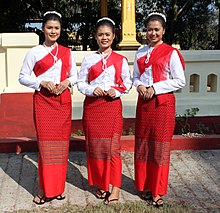
Back المون Arabic المون ARZ Monlar Azerbaijani Моны Byelorussian Мони Bulgarian မဲင်ꩻလိုꩻခွိုꩻ BLK Mon (poble) Catalan خەڵکی مۆن CKB Mon German Μον (εθνότητα) Greek
 Mon girls wearing traditional dress in Mawlamyine | |
| Total population | |
|---|---|
| c. 1.7 million | |
| Regions with significant populations | |
| c. 1.1 million[a][1] | |
| 200,000[b] | |
| 1,000[b] | |
| Languages | |
| Mon, Burmese, Thai, Lao | |
| Religion | |
| Theravada Buddhism, Mon folk religion | |
| Related ethnic groups | |
| |
The Mon (Mon: ဂကူမန်ⓘ; Thai Mon=ဂကူမည်; Burmese: မွန်လူမျိုး, pronounced [mʊ̀ɰ̃ lù mjó]; Thai: มอญ, pronounced [mɔ̄ːn] ⓘ) are an ethnic group who inhabit Lower Myanmar's[2] Mon State, Kayin State, Kayah State,[3] Tanintharyi Region, Bago Region, the Irrawaddy Delta, and several areas in Thailand (mostly in Pathum Thani province, Phra Pradaeng and Nong Ya Plong). [4][5][6] The native language is Mon, which belongs to the Monic branch of the Austroasiatic language family and shares a common origin with the Nyah Kur language, which is spoken by the people of the same name that live in Northeastern Thailand. A number of languages in Mainland Southeast Asia are influenced by the Mon language, which is also in turn influenced by those languages.[7][8][9]
The Mon were one of the earliest to reside in Southeast Asia, and were responsible for the spread of Theravada Buddhism in Mainland Southeast Asia.[10][11] The civilizations founded by the Mon were some of the earliest in Thailand as well as Myanmar and Laos. The Mon are regarded as a large exporter of Southeast Asian culture.[12] Historically, many cities in Myanmar, Thailand, and Laos today, including Yangon, Pathum Thani, and Vientiane were founded either by the Mon people or Mon rulers.
Nowadays, the Mon are a major ethnic group in Myanmar and a minor ethnic group in Thailand.[6] The Mons from Myanmar are called Burmese Mon or Myanmar Mon. The Mons from Thailand are referred as Thai Raman or Thai Mon.[13][14] The Mon dialects of Thailand and Myanmar are mutually intelligible.[15]
Cite error: There are <ref group=lower-alpha> tags or {{efn}} templates on this page, but the references will not show without a {{reflist|group=lower-alpha}} template or {{notelist}} template (see the help page).
- ^ "The World Factbook". CIA.gov. Retrieved January 24, 2018.
- ^ Bauer 1990, p. 14.
- ^ World Bank Group (October 1, 2019). Myanmar - Peaceful and Prosperous Communities Project : Social Assessment (PDF) (Report). Retrieved April 4, 2021.
- ^ Foster 1973, p. 204.
- ^ Bauer 1990, p. 19–23.
- ^ a b Gaspar Ruiz-Canela (June 1, 2017). "Mon, Thai minority who once ruled Southeast Asia". Agencia EFE. Retrieved September 5, 2019.
- ^ Matisoff 1991, p. 482.
- ^ McCormick & Jenny 2013, p. 86.
- ^ Jenny 2013.
- ^ Swearer 2002, p. 130–131.
- ^ Khin May Aung (July 24, 2015). "Historical Perspective on Mon Settlements in Myanmar" (PDF). Burma/Myanmar in Transition: Connectivity, Changes and Challenge. International Conference on Burma/Myanmar Studies.
- ^ Desakura (February 24, 2020). "Where does the Mon Pak Lad shortcut?". Stationremodel. Retrieved August 7, 2020.
- ^ Foster 1973, p. 211.
- ^ Ngamying, Keeratiburana & Thidpad 2014.
- ^ Bauer 1990, p. 34.
© MMXXIII Rich X Search. We shall prevail. All rights reserved. Rich X Search